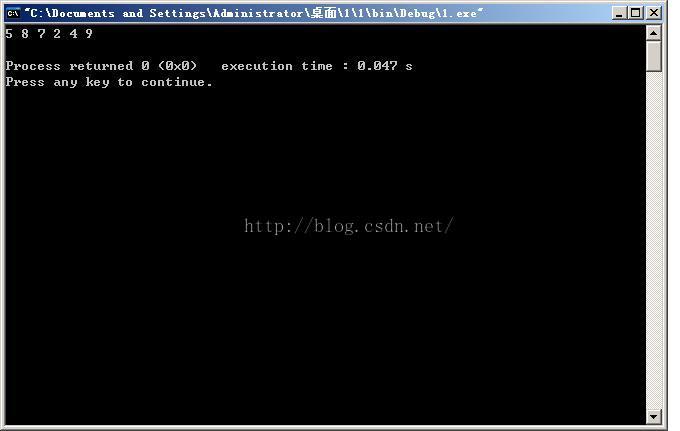2015-9-14 项目2 - 建设“顺序表”算法库
1.问题及代码
领会“0207将算法变程序”部分建议的方法,建设自己的专业基础设施算法库。这一周,建的是顺序表的算法库。
算法库包括两个文件:
头文件:list.h,包含定义顺序表数据结构的代码、宏定义、要实现算法的函数的声明;
源文件:list.cpp,包含实现各种算法的函数的定义
请采用程序的多文件组织形式,在项目1的基础上,建立如上的两个文件,另外再建立一个源文件,编制main函数,完成相关的测试工作
<span style="font-size:14px;"><span style="font-family:Microsoft YaHei;"><strong>list.cpp</strong>
</span></span><span style="font-family:Microsoft YaHei;">#include <stdio.h>
#include <malloc.h>
#include "list.h"
//用数组创建线性表
void CreateList(SqList *&L, ElemType a[], int n)
{
int i;
L=(SqList *)malloc(sizeof(SqList));
for (i=0; i<n; i++)
L->data[i]=a[i];
L->length=n;
}
//初始化线性表InitList(L)
void InitList(SqList *&L) //引用型指针
{
L=(SqList *)malloc(sizeof(SqList));
//分配存放线性表的空间
L->length=0;
}
//销毁线性表DestroyList(L)
void DestroyList(SqList *&L)
{
free(L);
}
//判定是否为空表ListEmpty(L)
bool ListEmpty(SqList *L)
{
return(L->length==0);
}
//求线性表的长度ListLength(L)
int ListLength(SqList *L)
{
return(L->length);
}
//输出线性表DispList(L)
void DispList(SqList *L)
{
int i;
if (ListEmpty(L)) return;
for (i=0; i<L->length; i++)
printf("%d ",L->data[i]);
printf("\n");
}
//求某个数据元素值GetElem(L,i,e)
bool GetElem(SqList *L,int i,ElemType &e)
{
if (i<1 || i>L->length) return false;
e=L->data[i-1];
return true;
}
//按元素值查找LocateElem(L,e)
int LocateElem(SqList *L, ElemType e)
{
int i=0;
while (i<L->length && L->data[i]!=e) i++;
if (i>=L->length) return 0;
else return i+1;
}
//插入数据元素ListInsert(L,i,e)
bool ListInsert(SqList *&L,int i,ElemType e)
{
int j;
if (i<1 || i>L->length+1)
return false; //参数错误时返回false
i--; //将顺序表逻辑序号转化为物理序号
for (j=L->length; j>i; j--) //将data[i..n]元素后移一个位置
L->data[j]=L->data[j-1];
L->data[i]=e; //插入元素e
L->length++; //顺序表长度增1
return true; //成功插入返回true
}
//删除数据元素ListDelete(L,i,e)
bool ListDelete(SqList *&L,int i,ElemType &e)
{
int j;
if (i<1 || i>L->length) //参数错误时返回false
return false;
i--; //将顺序表逻辑序号转化为物理序号
e=L->data[i];
for (j=i; j<L->length-1; j++) //将data[i..n-1]元素前移
L->data[j]=L->data[j+1];
L->length--; //顺序表长度减1
return true; //成功删除返回true
}1
可以在另外的文件中,定义代码,使用这些基础设施中的成果了。
例如,设计mian.cpp用于测试:
main.cpp
#include "list.h"
int main()
{
SqList *sq;
ElemType x[6]= {5,8,7,2,4,9};
CreateList(sq, x, 6);
DispList(sq);
return 0;
}
</span>
<span style="font-family:Microsoft YaHei;"><span style="font-size:18px;"><strong>main.cpp</strong>
</span></span><span style="font-family:Microsoft YaHei;">#include "list.h"
int main()
{
SqList *sq;
ElemType x[6]= {5,8,7,2,4,9};
CreateList(sq, x, 6);
DispList(sq);
return 0;
}
</span>
2.运行结果
3.心得体会
算法库非常便捷,在运用了算法库后,只需在main函数中写出函数即可,只要在编写代码时将自己编写的算法库包含进去就可以了。
4.学习心得
在以后的编码过程中,应该使用这种主函数与算法库分开的方式。5
只在main函数中写出问题的求解函数,而在另一个源文件中编写出所有有用的算法。这样可以极大提高程序运行效率。
